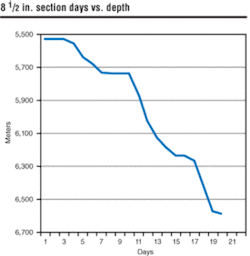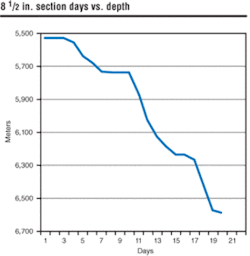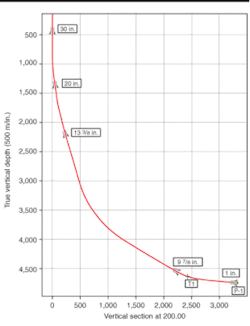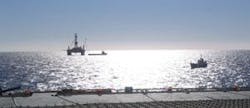Statoil drills high angle HP/HT well on Kristin Development
One of the longest horizontal displacements
Barry Fitzgerald, Jason Mcgee, Jakob Mo,Halliburton, Baroid Fluid Service
Production from Statoil’s Kristin oil and condensate (light oil) field in the Norwegian sector of the North Sea began on Nov. 3, 2005. The operator developed the field from 12 subsea wells drilled from four templates using two semisubmersible rigs, the second rig being Saipem’sScarabeo 5. Eight of the wells are highly deviated - the first of their kind to be drilled as subsea completions in a field with high-temperature and high-pressure.
Statoil drilled and cemented a 7 in. liner in one of the longest horizontal displacements in a HP/HT reservoir. The operator drilled the P-1H well to 6,580 m measured depth (4,735 m total vertical depth) with the 8 1/2in. section drilled at 85° for 1,072 m through the reservoir. Statoil drilled the well using Smedvig’sWest Alpha semisubmersible in 350 m of water in the Norwegian sector of the North Sea, approximately 150 mi from Trondheim.
Statoil operates the Kristin field in partnership with Petoro, ExxonMobil AS, ENI, Norsk Hydro ASA, and Total. The field is the most extreme HP/HT development to be drilled to-date offshore Norway with a bottomhole pressure (BHP) close to 911 bar (1.97 SG EMW) and bottomhole temperature of 175°C.
Drilling HP/HT wells
Drilling HP/HT wells offers up special challenges, the main one being to stay within the pore pressure/fracture gradient window. This window limits the BHP exerted by the column of drilling fluid from 1.97 SG (pore pressure gradient) to 2.14 SG (expected fracture pressure gradient). A riser margin then narrowed the window even further by increasing the lower limit by nine points. After drilling the first three wells it was decided to increase the angle drilled through the reservoir from 50° to 85° to maximize the productivity of the wells. The Kristin drilling team’s challenge was not only to drill the P1-H well within these limitations but also to run and cement the liner in place without losses to ensure a fit-for-purpose well ready for the completion phase.
The drilling team drilled the top hole sections with seawater and bentonite sweeps. They then drilled the 17 1/2 in. section with the service company’s water-based mud system through the highly reactive Tertiary shale sequences. Statoil chose to drill these sections with this water-based mud system because of the section’s high inhibitive properties and low dilution rates. The Kristin drilling team built up the well to 17° in this section before doing the main directional work in the 12 1/4 in. section where the angle increased up to 85° by section total depth. The drilling team drilled both the 12 1/4 in. and 8 1/2 in. sections with the service company’s n-alkane-based synthetic oil-based mud. The operator chose this fluid for the Kristin project based on its very successful track record in HP/HT drilling, particularly in the UK sector of the North Sea. The team drilled the 12 1/4 in. section on P1-H and ran 9 7/8 in. casing without any significant problems. They then conditioned the n-alkane-based synthetic oil-based mud and raised the mud weight to 2.03 SG to drill the high angle 8 1/2 in. section.
Stress cage trial
Now that production has started, Statoil expects that future wells will have to be drilled through depleted zones. With this in mind, the drilling team decided to conduct a ‘stress cage’ trial before drilling this section to test out the logistics and effects on the drilling fluid when loading the system with particulates. The team added over 100 kg/cu m of sized bridging agent (ground marble) and lost circulation material (compressed carbon) to the drilling fluid as drilling started. The majority of the drilling fluid properties remained constant, as can be seen from the plots. After monitoring the effect on drilling and the drilling fluid, the drilling team screened out the material from the system and continued normal operations.
Using the n-alkane-based synthetic oil-based mud in an HP/HT environment can give significantly lower ECDs compared to normal OBM and has proven to be exceptionally stable under these conditions. The Kristin drilling team targeted the 100 rpm viscometer reading at a dial reading of 30 for optimum hole cleaning, but this number can be lowered to further minimize ECD to a viscometer dial reading of 25 without impacting stability. The mud weight showed little variation throughout this section and the drilling team saw no signs of barite sag, indicating that the well engineered drilling fluids performed successfully in a very challenging environment that is prone to barite sag.
“The drilling fluids from Halliburton Baroid Fluid Services performed well in this reservoir. It is one of the factors that have contributed to our success,” said Svein Hansen, Statoil Drilling Fluids contract supervisor.
Statoil and its team drilled the 8 1/2 in. section in 20 days, four days ahead of schedule. The team drilled the entire well 40 days ahead of the budget timeline.
Cementing liner
However, it is not enough to drill these wells without incident. The liner also has to be run and cemented to complete a fit-for-purpose well. This requires good zonal isolation to shut off water production if and when necessary.
After drilling the well to total depth, the drilling team ran a 7 in. liner, 1,072 m long, in the 8 1/2 in. hole to bottom and set it at 6,577 m. They then cemented it. The service company’s cementing team pumped a 25 cu m spacer at 1,000 liters per minute (LPM), followed by the first dart, which helped prevent spacer and cement contamination in the string. They then pumped 27.2 cu m of 2.06 SG slurry at 400 LPM. The cementing team then released the second dart and displaced it with 64.8 cu m of 2.03 SG mud using the rig pumps. They decreased the rate from 1,000 LPM to 500 LPM during displacement, according to the service company’s hydraulic calculation program. The cementing team saw no indication of shearing the second plug and stopped the displacement after 4,048 strokes equivalent to 96% pump efficiency. FCP was 97 bars, and bled back to the cement unit with no backflow. The team then set down the liner packer with 55 tons at 14 RPM. They then applied about 20 bars of pressure on the string and pulled it above the polished bore receptacle. The team circulated two times bottom’s up at 1,400 LPM, and separated the spacer contaminated mud out at surface. They then pulled the string out of hole.
The advantages of the fluid system teams working closely together are evidenced by the success of the job. “Having the fluid services and cementing teams working on the same project improves communications and exchange of data. It gives us a better end result,” said Hansen.
As production increases and depletion begins, further challenges await the Kristin project, the world’s first subsea HP/HT development. The service company team together with Statoil are already working to meet and successfully overcome these challenges.•



